|
The railways in the region, a
brief look in history.
Already in 1816, before the independence of Belgium, just
after the fall of Napoleon, there were first ideas of making a Belgian
Railway. Thomas Gray and John Cockerill had the idea to devellop
a railway (animal traction) for the transport of coal between Belgium
and the Netherlands. In the beginning of 1830, some railways (animal
traction) were build in the backyard of the coalmines or between the
coalmine and the nearest channel. (Bois du
Luc, Grand Hornu, Haut and Bas Flénu…). In 1835 horse traction
was replaced by machines.
The 5th mai 1835, Belgium had it's first public railway
between Brussels and Mechelen. Steamtrains were used. The first public
railway in Great Brittain was in 1825. Still we had to wait for Germany
till 7 december 1835. France had it's track in 1837 and in 1839 the United
States and Italy followed.
Starting in 1835 the Belgian gouvernement made a study
if it would be possible to give the region between Sambre and Meuse a
steamtrain railway. This region was rich on raw material, slate quarries,
saw-mills and had metallurgical industry. A steamtrain track would make
it easy to transport all the goods to Charleroi.
In 1845 a limited liability company was founded: "Chemin
de fer l'Entre Sambre et Meuse" (Railway between Sambre and Meuse). It
was a Brittish company (W. P. Richards Co.) who had the contract to build
and exploit the railway in this region. Rapidly new tracks were build
after the opening. Several lines were opened:
Charleroi – Walcourt
27 november 1848
Walcourt – Silenrieux
6 november 1853
Cerfontaine – Mariembourg 8 june 1854
Mariembourg – Vireux 15 june 1854
The section which interests us most directly: Mariembourg - Vireux. In Vireux, a listed line 148 (Brussels - Charleville) joined the French network.
In 1854, the track between Sambre and Meuse merged with
the track Antwerp - Rotterdam. This unity was called "Grand Central Belge".
On the 1st of january 1897, the line Mariembourg - Vireux was taken by
the Belgian State.
Because Vireux was in France, a borderstation was build in Vierves on
grounds offered by the earl of Vierves. Treignes only had a stopping place.
Only later a borderstation was build in 1902. Because more and more trains
were comming there, it became bigger and bigger. In the past the station had 7 railtracks
and a turn-table. The building is still today very impressive with it's
two high parts. On the first floor appartments and downstairs a custom
house. It's the widness of these precious times.
In 1925, the Belgian railways wanted to double the railtrack
between Mariembourg and Treignes. Today you still can see some bizarre
spots like the bridge next to railway crossing at Olloy and the beginning
of the perforation of the tunnel at Abannets. Nowadays nature
has reclamed its rights and covers the entrance with vegetation.
The track we use is called track 132
in the archives of the SNCB, the track was used until 29 september
1963 for public use. The transportation of goods on the part Mariembourg – Nismes
was eliminated on 12 october 1977. Only the part Mariembourg – Nismes
had double tracks.
From Mariembourg to Treignes – track
132 D.
Track 132, Mariembourg - Treignes
goes trough the valleys of "La Brouffe", "l’Eau
Blanche", "l’Eau
Noire" and " Viroin". The name « Three Valleys» comes
from the last 3 rivers. The railway goes trough following villages
: Nismes, Olloy sur Viroin, Vierves and Treignes. 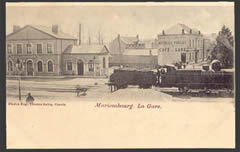
This track of 14km goes trough the landscape
of the river Viroin and passes 3 different geographical regions.
The Fagne (Don't confuse
with "les Hautes Fagnes") is a great clay sinking with slate
underneath. This region has a low population density
and is covered with woods and prairies. Mariembourg is situated in
this region.
The Calestienne is
the region crossed by the track between Mariembourg and Olloy.
Between Olloy and Treignes, you can see the Calestienne on your left
site. The characteristics of this region are a succession of lime ridges and
valleys rich of silt. The hills remained stripped until the beginning of
the XXnd century, they were reserved as meadow for the goats and sheep.
The nature of the ground and the orientation of the hillsides make it possible
to observe a hot and dry microclimate. A particularly rich flora and fauna
can be found here. Moreover, the calcareous nature of the ground makes
it possible to observe many collapses and the presence of several caves.
These caves allowed the habitation since the ancient times.
In the valleys, cereal agriculture developed.
Last comment, the presence of iron ore made it possible to develop the
iron and steel industry.
The Ardenne. The solid ardennes massif is present here, in
the south of the Meuse. The first buttresses are visible in the south
of the line starting from Olloy sur Viroin. (On the right while going
towards Treignes). The important forest solid mass, primarily of the
leafy trees, represents and represented an important activity for the
area. The exploitation of the forest solid mass brought to the inhabitants
a whole series of activities related to wood (Wood of furnishing, frame,
heating, of mine, clog factories, cooperage, charcoal....)
If one observes a little bit the area and if you put it in a broader
context, we can observe that the zone of the l'Eau Blanche and the Viroin constitutes
an economic axis which was important a few decades ago. Not only of the
important richness was exploited, but moreover the valleys allowed the
evacuation of it. Nothing astonishing thus so that the railroad settles
and gives a great economic advancement to the area. The richnesses being
is exhausted or regarded as economically nonprofitable; the rail transport
was abandoned. This corridor of communication in addition caused certain
covetousnesses. Thus during war 14-18, the railway line allowed an easy
communication towards Charleville and Verdun...
Mariembourg.
In 1546, under the reign of Marie
of Hungary, sister of Charles Quint, a fortress is set up which takes
the name of Mariembourg. This fortress of plain protected the south
from the Netherlands of Charles the Fifth of France. Marie of Hungary chooses
the ground of Vérofle
to realise her project of construction. These grounds belonged, as
of the IXe century to various religious communities; abbey of Lobbes, principality
of Liege, brood of Norbertines (Floreffe). In 1554, the fortress was
conquered by Henri II of France and was restored in 1559.
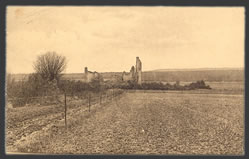 At this same
time, the castle of Fagnolle was destroyed. This castle of plain is located
at a few kilometers of the city and the visit of the ruins deserves a
small detour. At this same
time, the castle of Fagnolle was destroyed. This castle of plain is located
at a few kilometers of the city and the visit of the ruins deserves a
small detour.
In 1659 Mariembourg becomes French again (Louis XIV - treaty of the
Pyrenees) in 1815 to be included with the Kingdom of the Netherlands.
Belgian independence in 1830 restored the places for the Kingdom of Belgium.
Small anecdote, did you know that Mariembourg was the last Belgian city
under Napoleonean administration after the battle of Waterloo and that
Givet, which is located a few kilometers away (in France), resisted some
time after the abdication of Napoleon?
 When you visit Mariembourg observe the plan of the streets. They are
traced out like a star around the center place, a circular boulevard (old
fortifications) enclosing the city. This layout is typically related
to the military history of XVIth century... it allowed canon shooting! When you visit Mariembourg observe the plan of the streets. They are
traced out like a star around the center place, a circular boulevard (old
fortifications) enclosing the city. This layout is typically related
to the military history of XVIth century... it allowed canon shooting!
With the visit of Louis XIV in the city, there remains a typical piece
of music, the swing of Mariembourg or dance of the bouquet, carried out
in 1692. During the long French period (1659 - 1825), Mariembourg provided
a number of soldiers, and the Napoleonean time is still present in the
memories.
In 1830, after the departure of the Dutch troops, the population would
have liked being a part of France.
The fortifications were dismantled
in 1855 (Convention of the fortresses - London 1831).
The development
of the city was supported by the creation of the railroad and the dismantling
of the fortifications. Nearly 200 railwaymen lived in the city with the
apogee of the rail and the habitat extended, being more enclosed in the
yoke of the fortifications.
The station was an important junction of railways,
it assembled five lines, towards Charleroi, Hastière, Vireux (Reims - Charleville),
Couvin and Chimay (Momignies - Anor). Today, the "RAVEL" replaced
the railway line connecting Mariembourg to Hastière.
It is tourism
which makes the city live today ....
Installations of the CFV3V in Mariembourg.
The installations of the CFV3V are completely separated from those of
the SNCB. Indeed, the difference in regulation does not authorize a common
exploitation on the site of the SNCB.
The installations of the CFV3V are easily accessible
by foot from the SNCB station... but don’t follow the railtrack!
The deposit of Mariembourg (LMG) is built out of red bricks, the roof
being out of concrete. The architecture of the deposit is rather particular,
just like in Florennes, the building is in rotunda.
The rotunda of Mariembourg is the last in service and it shelters a
part of the material of the association. Originally, 6 railtracks were in
this building. Currently, 5 tracks are in service. Under track 2, we
find a pit which must allow the inspection and the maintenance of the
machines.
The rotunda was never served by a turntable. Triple switches make it
possible to reach the various railtracks.
On the site, we find, in service, a water tower and a water crane which
are used for the provisioning of the steam engines. Next to the water
crane, a second inspection pit can be found.
Nearby also we find the coal stockyard
and a loading crane going from 1910. Opposite the coal stockyard is the
wood reserve. On the other side of the rail track of the SNCB, we find
a little barrier guard house, occupied by the association.
The departure of the train is from one of the platforms. On the site, to finish,
we find the reception building. A great parking place for visitors can be found
at the back of the rotunda, near the water tower.
From Mariembourg to Nismes.
This first section of the course is rather short.
The first road that we cross carries out to the RAVel track. The latter
carries out to Hastière
on the site of the old railroad. We cross the Fagne and the first meadow
on the right names the "Meadow of the Huts". In XVIème
century, an epidemic of plague devastated the area and it is in this
place that the huts intended for the patients were built. Here also,
the corpses were cremated.
From this period we go back to the worship Saint Roch,
very present in the area. The tradition wants that Saint Roch looks after
the patients until he catches their plague. He isolated himself in the
forest, a dog came to supply him, an angel came to look after him and
cures the saint. This history explains why, in all the area the worship
of Saint Roch is still living and there are many little chapels where
the saint is represented, accompanied by his dog. Let us be lenient,
we find the same legend elsewhere and more particularly in France.
The
railroad crosses perpendicularly the calcareous grounds by going right
towards the hill of the “Rock à Lomme”.
At the foot of this rock the l'Eau Noire (Black Water) and the l'Eau Blanche (White Water) meet each other to form
the Viroin river. A little further, we arrive at Nismes, first station.
On
the left side of the track we find the "Mountain of the Boxwood".
It acts as one of the first natural reserves created by Ardenne and Gaume
in October 1947. These boxwood solid masses (buxaie), which develop on
the limestones slopes, are characteristic for the vegetation of the area.
This plant sub meditarian benefits from an excellent exposure to the
sun finds here its establishment most septentrional. The boxwood combined
with the oaks and form at certain places an excessively dense thickness.
In the dry lawns, one finds a rare flower immortalized
by the famous Belgian painter Redouté (born in Saint Hubert in 1759), the pink
pimpernel also named the "rose tree of Mariembourg".
Nismes.
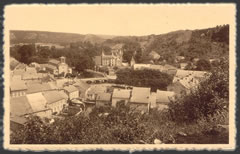
The station of Nismes was built in 1868. This superb
gray stone building of the country is located a little apart from the
village. The building of the station became a private housing. At the
beginning, the road of Dourbes did not cut the platform.... The protection
of the PN (level crossing) had not to be ensured by a member holding
up a disc 21 (prohibition to cross) like currently! 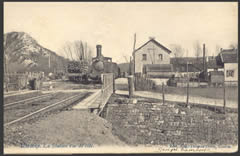
Today, Nismes became the center of the entity of
Viroinval. The village is one of the oldest of the area. Human traces of
occupation go up at 35.000 years before JC (Perforated Rock at Nismes,
hole of the Badgers in Vaucelles, hole of the Abyss in Couvin). Certain
traces go up even at -70.000 years! (flint of Gimnée).
The first historical information of which we can
be certain goes up to the Xth century, Nismes belonged to the abbey
of Saint Germain des Prés. The king of France, Robert the Piles received this abbey,
the grounds of Nismes (like those of Boussu, Couvin, Pesche and Frasnes).
Thereafter, he gave the grounds to his sister Hedwige, which married
Régnier IV of Hainaut. In 1096, Baudouin II of Hainaut sold these
grounds to the episcopate of Liege.
During more than 3000 years, the prosperity of the country is related
to the iron and steel industry. Indeed, the iron ore is present and the
forests abound. The iron and steel industry made fortune in the XVIII
and XIXth centuries of the Licot family. Their castle, old convent cistercian,
transformed, is today the seat of the municipal authorities of Viroinval.
The foundry was located at the bottom of the park of the castle and used
the ore extracted from Abannets and Fondrys.
The foundries also used many waste of the foundries
of the gallo Roman time. This raw material was called "buckwheat Crayats".
The nickname of Crayats designated a long time in the popular speech
of the inhabitants of Nismes.
With the decline of the low hearths, the crayats
are dispatched towards the forging mills of Providence in Charleroi,
who’s Mr. Licot was
one of the founders.
The site of the low hearths was transformed into sawmill, still active
today.
At the beginning of the XXth century, the clog industry developed in
Nismes.
In Nismes, it is advisable to visit the farm of Maladrerie, place where
in 1527 the people with the plague were treated (Try Saint Roch) as well
as the House of the Baillis.
Another attraction, “Fondry aux chiens”,
spectacular site of an old exploitation of extraction of the iron ore.
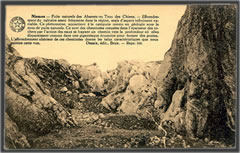
From Nismes to Olloy sur
Viroin.
Here we are in the valley of Viroin and we will remain
in it till the end of the railway in Treignes.
Soon after having left the station of Nismes, we
notice impressive industrial buildings, it's the old tannery of Houbon.
We find ourselves at the foot of the Roche à Lomme. The tannery
of which the buildings will be restorated
(there are plans to make 16 apartments in there) culminated in the XIX
century. Tanning, an extract of the bark of the oak-tree, which there were a lot of in this region at that time .

"Roche à Lomme" or sometimes
wrongly spelled as "Roche à l'Homme" makes people think
of a legend of a rider falling from his horse. Nothing of the sort, the
rock named like this was just a boundary-stone for the south of "Pagus
Lommensis". This land got its name from the river Lomme, a tributary
to the Lesse. The river constitutes the north-east border of this land.
At the very top of the rock you have a splendid view over the whole
region. The summit with its standing cross was occupied since the neolithic
time. A square tower of roman origin inclined for a long time the spot.
A roman garrison guarded the road coming from Saint Quentin and crossing
the Sambre and Meuse.
Soon after the tannery, the railway enters the tunnel
of Abannets which is about 500 meters long. The Viroin revolves the
boulder and finds the railway at the exit.
The name "Abannets" is derived from
the obsolete word "abannir"= "to forbid". A decree
of the bishop of Liege forbidded to have cattle graze in these areas
full of truffle holes. One of the most popular Abannets is the "Fondry
aux chiens"
After the tunnel we find at our left a very important quarry. The exploitations
destined for extracting schist, sandstone or calcareous were very numerous
in this region. Most of the houses were built out of landstones (grey
and sometimes pink). A lot of the quarries were exploited just to build
local homes.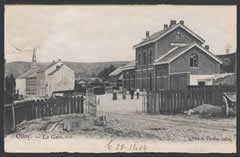
Once the quarry passed, the railway changes into a straight level (with
automatic barriers) crossing the N99 so to enter the station of Olloy
sur Viroin. Just before the level the train is sensitive slowing down
in order to be able to cross it. A fundamental signal controls the passage.
Olloy sur Viroin.

The station of Olloy is the property of the municipal
administratives of Viroinval.
The building is fully restored in 2014.
Various projects to do something with it are currently being studied.
The station was built in 1901, constructed with
red bricks and with a magnificant roof in glass to protect the travellers
of platform 1 against bad weather. When the SNCB managed the line it
won for several years a contest for the most beautiful flowered station.
It was also used for many times as a film scenery. Several episodes
of the film "Maigret" were
shooted at this station.
At the exit of the station a relative old signal is these days still
working.
In 1909, a local railway permitted to reunite Olloy with Oignies. So
the Olloy station made it possible for travellers and goods (as schist,
sandstones and wood) to get connection between the railways of the SNCB and
SNCV.
In 2004 the municipal territory was excavated and a protohistorical
fortification was updated (Celtic period). Olloy became part of the manor
of Liege, the vasal of the dukedom of Bouillon and the principality of
Liege. For a long time the iron-foundry and quarries gave work to the
inhabitants. Today they are living from tourism.
From Olloy sur Viroin
to Vierves.
Leaving the station, the railway is infiltrating
the centre of the town, between the houses, next to the church which
was recently reconstructed, so to finally reach the foot of the Rolinveaux
hill. From Mariembourg to Treignes, the railway is continually descending,
except at the hill. At the summit of this little steep path we find an
optional stop at the level of a hotel-restaurant(just shake the red drape
tightened in the fence).
Vierves.
 |
Vierves-Viroin
is catalogued as one of the most beautiful towns of Walloonie.
The town is built around a solemn castle. In the XV century, the
manor changed into a barony. Today the castle preserved its appearance
of the XVIII century, thanks to the reconstruction after a fire.
|
The town is known for its traditions
such as the legend (XII century) of Robert II of Vierves who was
very jalous of the rich Johan Simons. He made false charges at
the address of this man and had him burned alive after taking him
for a walk through the whole town.
This ceremony is repeated each
year at carnaval !
Here you find the center of Marie-Victorin where the activities
are based on education of nature.
The station of Vierves which
was at first a border station and this for many years, remained
abandoned during a certain period of time. The building was recently
restored and protects today the housing facilities of the Center
Marie-Victorin.
Did you know that there
is a vineyard for red wine along the national road 99 ?
|
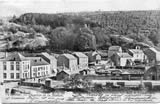
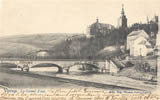

|
From Vierves to Treignes.
The railway is twisting along the Viroin
river in a beautiful valley, we are approaching the end of our traject.
Treignes.
Treignes is called "the town of musea".
You can find here :
- the museum of agricultural machinery
- the museum "malgré tout"= "despite of everything "
- the ecological museum
- the railway museum

Next
to these musea you can also visit the ruins of a gallic-roman villa,
but the town became mainly known through the person Toine Cullot, the
mayor of Trignolles, created by Arthur Masson. In the main street of
the town, a place is dedicated to this person from Walloonie. The
novel of Arthur Masson, "Thanasse and Casimir" is put in scene.
The station of Treignes.
The station was acquired in 1972
by the University of Brussels to set up a laboratory for the study
of the fauna of the region.
We have described the building earlier in this brochure.
As the station was used as border station
you can still find wooden watch-towers, they helped the custom house
officer to survey and inspect the goods-train.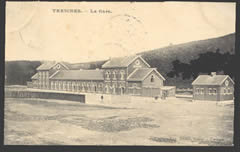
It is no coincidence that one of the musea is called "Musée de Malgré-Tout"(despite of everything).
This museum is located a few hundred meters from the train station.
The CFV3V in Treignes.
A few steps away from the
station, you can see several important buildings looking like hangars.
You find yourself in front of one of the places the most important of the CFV3V.
These buildings are for the museum, the cafeteria and especially a workshop.
We will be talking about the museum later. In the cafeteria, you
will be welcomed with pleasure by the staff. Still we have to talk about
the workshop.
This is where the new acquiries of the
association are restored en serviced. Thanks to the members of the CFV3V and the Formation
Centre of Treignes (CFT) we can work on engines, rail cars, wagons, etc.
on the two tracks(45 metres each) and a pit of visit installed for this purpose.
A rolling bridge that can lift 20 tonnes and lots of machinery and tools
are available for the association to
troubleshoot, repair and restore these old engines. For the old engines we sometimes have
to rebuild complete pieces from scratch. Because most of the pieces cann't
be bought anywhere !
On the site of Treignes, there are some
interresting discoveries to make.
In front of the station, at the back of the site there is a turning
table. It's working on manpower, you could say that the volonteers to
make it turn are not legion. For the curious amongst us, in the slide of
the bridge you can find traces of a machine-gun from Worldwar 2.
Also
at the back there is a typical water tower which is not standing at the
CFV3V site, but it's a part of the surroundings of the railway.
At the entrance of the site, there is a controlcabinet that made it
possible to serve the railway-switches.
There are also 2 fundamental signals and a waterhoisting crane(on the guay) which
is not connected. Next to the crane there is the old building of the lampchamber
lodging, today certain pieces belonging to the rural life museum are there.
This is where the track ends after 14 km.
Not far after the bridge over the Viroin, the track goes into France where
it is derailed. In old times this track went through the tunnel of Najauge
which is now used to grow mushrooms...
|

